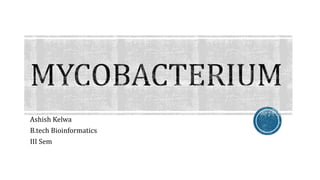
Mycobacterium
- 1. Ashish Kelwa B.tech Bioinformatics III Sem
- 2. INTRODUCTION Mycobacterium, genus of rod-shaped bacteria of the family Mycobacteriaceae (order Actinomycetales), the most important species of which, M. tuberculosis and M. leprae, cause tuberculosis and leprosy, respectively, in humans. M. bovis causes tuberculosis in cattle and in humans. Some mycobacteria are saprophytes (i.e., they live on decaying organic matter), and others are obligate parasites. Most are found in soil and water in a free-living form or in diseased tissue of animals. Streptomycin, rifampin, and species-specific antimicrobial agents have had some success in treating Mycobacterium infections. Mycobacterium leprae
- 3. Classification Mycobacteria are slender rods that sometimes show branching, filamentous forms resembling fungal mycelium. The genus Mycobacterium contains three groups: o Obligate parasites o Opportinistic pathogens o Saprophytes
- 4. Obligate Parasites • Mycobacterium tuberculosis complex Contains M. tuberculosis, M. bovis, M. africanum, M. microti, M. canetti, M. caprae and M. pinnipedii • Mycobacterium leprae
- 5. Opportunistic Pathogens Non-tuberculosis mycobacteria (NTM) This group contains mixed group of isolates from diverse sources: birds, cold-blooded and warm-blooded animals, from skin ulcers, and from soil, water and other environmental sources. They are opportunistic pathogens and can cause many types of disease.
- 6. Pathogenesis Source of infection: Open case of pulmonary tuberculosis Mode of infection Direct inhalation of aerosolized bacilli contained in the droplet nuclei of expectorated sputum. Infection also occurs infrequently by ingestion for example, through infected milk, and rarely by inoculation.
- 7. Transmission of M.tuberculosis Millions of tubercle bacilli in lungs (mainly in cavities). Coughing projects droplet nuclei into the air that contain tubercle bacilli. One cough can release 3,000 droplet nuclei. One sneeze can release tens of thousands of droplet nuclei
- 8. Infection The initial infection with M. tuberculosis is referred to as a Primary infection Subsequent disease in a previously sensitized person, either from an exogenous source or by reactivation of a primary infection is known as Postprimary tuberculosis Both forms exhibit quite different pathological features.
- 9. Difference b/w Primary and Postprimary tuberculosis Characteristics Primary Postprimary Site Any part of lung Apical region Local lesion Small Large Cavity formation Rare Frequent Lymphatic involvement Yes Minimal Infectivity* Uncommon Usual Local spread Uncommon Frequent *Pulmonary cases
- 10. Immunology Tubercle bacilli do not contain or secrete a toxin. The exact basis of their virulence is not understood, but seems to be related to their ability to survive and multiply in macrophages. Humoral immunity appears to be irrelevant. The only specific immune mechanism effective is the CMI.
- 11. The key cell is the activated CD4+ helper T cell which can develop along two different paths: The Th1 and Th2 cells Th1 dependent cytokines activate macrophages, resulting in protective immunity and containment of the infection Th2 cytokines induce delayed type hypersensitivity (DTH), tissue destruction and progressive disease
- 12. Laboratory Diagnosis Specimen Collection Type of lesion Specimen Pulmonary tuberculosis Sputum Early morning sputum samples should be collected for 3 consecutive days in a sterile container In case of renal tuberculosis, 3-6 morning urine samples should be collected Laryngeal swabs or bronchial washings Gastric lavage Renal tuberculosis Urine Tuberculosis meningitis CSF
- 13. Direct Microscopy Ziehl-Neelsen staining (hot staining method) Kinyoun’s method (cold staining method) Acid fast bacilli resist decolourisation with acid and alcohol once they have been stained with carbolfuchsin. AFB appear as pink, long, slender bacilli with beaded appearance. Ziehl-Neelsen Staining
- 14. Fluorescent staining by Auramine O or auramine rhodamine Mycobacterium spp. will fluoresce yellow against dark background under fluorescent microscope
- 15. Culture Concentrated specimen is inoculated on Lowenstein – Jensen’s medium and incubated at 370C for 2 – 8 weeks Colonies appear as buff coloured, dry, irregular colonies with wrinkled surface and not easily emulsifiable (Buff, rough and tough colonies) Colonies are creamy white to yellow colour with smooth surface and easily emulsifiable
- 16. Detection of antibodies Various methods such as enzyme linked immune sorbent assay (ELISA), radio immunoassay (RIA), latex agglutination assay have been employed for detection of antibodies in patient serum. However, diagnostic utility of these methods is doubtful. WHO has recommended that these tests should not be use for diagnosis of active tuberculosis.
Editor's Notes
- An obligate parasite is a parasitic organism that cannot complete its life cycle without exploiting a suitable host. If an obligate parasite cannot obtain a host it will fail to reproduce.
- Cerebrospinal fluid
